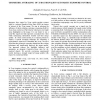Free Online Productivity Tools
i2Speak
i2Symbol
i2OCR
iTex2Img
iWeb2Print
iWeb2Shot
i2Type
iPdf2Split
iPdf2Merge
i2Bopomofo
i2Arabic
i2Style
i2Image
i2PDF
iLatex2Rtf
Sci2ools
101
Voted
ICIP
2010
IEEE
2010
IEEE
Geometric averaging of X-ray signals in automatic exposure control
Improper dose control in X-ray cardio-vascular systems leads to a reduced Signal-to-Noise Ratio (SNR) in regions of interest of the X-ray image. We aim at reducing the influence of direct radiation, entering a measuring field for X-ray dose control in a Flat Detector which gives too bright areas (highlights) in the image. It is our desire to use a norm-like signal size that represents a minimal dose value while maximizing information transfer and thus image quality. In a dose control system, it is common practice to employ a special averaging technique for computing a representative signal level controlling the X-ray. We have found that the geometric averaging outperforms the existing techniques and significantly improves the image quality. Our approach reduces the highlight influence and guarantees an adequate Contrast-to-Noise ratio for decentered objects. We provide convincing experimental results showing a strongly improved image quality with respect to contrast and detail.
Dose Control | ICIP 2010 | Image Processing | Image Quality | X-ray |
| Added | 12 Feb 2011 |
| Updated | 12 Feb 2011 |
| Type | Journal |
| Year | 2010 |
| Where | ICIP |
| Authors | Rudolph M. Snoeren, Peter H. N. de With |
Comments (0)

